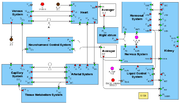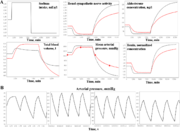Difference between revisions of "Modular model of the human CVS v.1"
Tagir Valeev (Talk | contribs) (DOI) |
|||
| (One intermediate revision by one user not shown) | |||
| Line 3: | Line 3: | ||
Using the [[Modular modeling|modular approach]] we have created a complex modular model of the human cardiovascular system (CVS) on the basis of: | Using the [[Modular modeling|modular approach]] we have created a complex modular model of the human cardiovascular system (CVS) on the basis of: | ||
| − | *[[Long-term model of the CVS/Renal system]] by Karaaslan et al. <ref>Karaaslan F., Denizhan Y.,Kayserilioglu A., Gulcur H.O. Long-term mathematical model involving renal sympathetic nerve activity, arterial pressure, and sodium excretion // Ann. Biomed. Eng. 2005. Vol.33. P.1607 - 1630.</ref> | + | *[[Long-term model of the CVS/Renal system]] by Karaaslan et al. <ref>Karaaslan F., Denizhan Y.,Kayserilioglu A., Gulcur H.O. Long-term mathematical model involving renal sympathetic nerve activity, arterial pressure, and sodium excretion // Ann. Biomed. Eng. 2005. Vol.33. P.1607 - 1630. {{doi|10.1007/s10439-005-5976-4}}</ref> |
*[[Short term model of the heart output regulation]] cerated by professor Soloyannikov. <ref>Solodyannikov Y.V. The elements or mathematical modeling and hemodynamics system identification. Samara: The university of Samara, 1994.</ref> | *[[Short term model of the heart output regulation]] cerated by professor Soloyannikov. <ref>Solodyannikov Y.V. The elements or mathematical modeling and hemodynamics system identification. Samara: The university of Samara, 1994.</ref> | ||
The models have the same formalisms - ordinary differential equations with descrete events, however they have different time scales: seconds in the short-term model, minutes in the long-term one. Merge of the models was based on the next two points: The "Heart" and "Arteris" modules from the long-term modular model contain the averaged parameters such as arterial blood pressure or arterial resistance described in more detail by the short-term model, in its turn, the long-term human CVS model contains a blood volume regulation mechanism based on the salt-water balance in the human body, while the short-term model keeps the blood volume parameter at a constant level. The established connections between the modules were taken from different models: | The models have the same formalisms - ordinary differential equations with descrete events, however they have different time scales: seconds in the short-term model, minutes in the long-term one. Merge of the models was based on the next two points: The "Heart" and "Arteris" modules from the long-term modular model contain the averaged parameters such as arterial blood pressure or arterial resistance described in more detail by the short-term model, in its turn, the long-term human CVS model contains a blood volume regulation mechanism based on the salt-water balance in the human body, while the short-term model keeps the blood volume parameter at a constant level. The established connections between the modules were taken from different models: | ||
| Line 14: | Line 14: | ||
[[Category:Cardiovascular system]] | [[Category:Cardiovascular system]] | ||
| + | [[Category:Modular modeling]] | ||
Latest revision as of 11:37, 1 July 2013
Using the modular approach we have created a complex modular model of the human cardiovascular system (CVS) on the basis of:
- Long-term model of the CVS/Renal system by Karaaslan et al. [1]
- Short term model of the heart output regulation cerated by professor Soloyannikov. [2]
The models have the same formalisms - ordinary differential equations with descrete events, however they have different time scales: seconds in the short-term model, minutes in the long-term one. Merge of the models was based on the next two points: The "Heart" and "Arteris" modules from the long-term modular model contain the averaged parameters such as arterial blood pressure or arterial resistance described in more detail by the short-term model, in its turn, the long-term human CVS model contains a blood volume regulation mechanism based on the salt-water balance in the human body, while the short-term model keeps the blood volume parameter at a constant level. The established connections between the modules were taken from different models:
Arterial pressure PA and cardiac output Vout from the short-term model are passed to the long-term model (after the averaging to avoid systole-diastole oscillations) Blood volume VSyst is passed to the short-term model
[edit] References
- ↑ Karaaslan F., Denizhan Y.,Kayserilioglu A., Gulcur H.O. Long-term mathematical model involving renal sympathetic nerve activity, arterial pressure, and sodium excretion // Ann. Biomed. Eng. 2005. Vol.33. P.1607 - 1630. doi:10.1007/s10439-005-5976-4
- ↑ Solodyannikov Y.V. The elements or mathematical modeling and hemodynamics system identification. Samara: The university of Samara, 1994.

